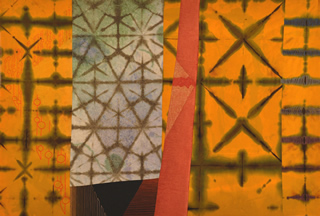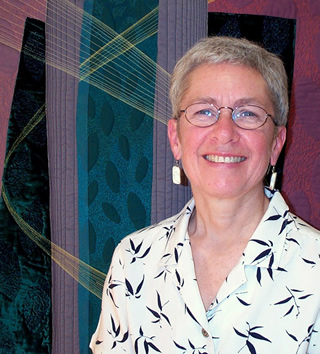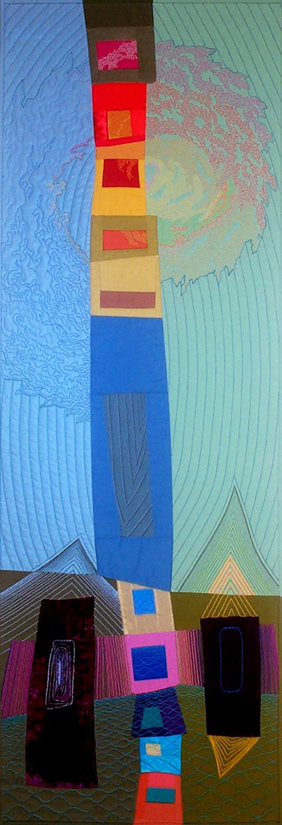Conversation Pieces
 |
|
|
 |
|
|
 |
|
|
 |
|
|
In some ways Leslie Carabas comes across like your average, lovable quilter, getting together with 15 fellow quilters in the Sierra Foothill town of Sonora to "talk about whatever is bothering us and work on our projects at the same time."
But, she says, "I've never seen anybody do the kind of quilting that I do. I use kind of a drawn line. I'll fill in areas as somebody would who uses a pencil or stylus of some sort."
Unlike traditional quilters, who piece together fragments of existing fabrics, incorporating into their art the designs on the original pieces, Carabas creates the pieces that make up her quilts on her own.
She dyes fabrics, erases the colors, dyes them again, and again, all to create a complex, layered effect.
"I also will fold fabrics, using different sizes of folds," she says, "then dye the edges of the folds. There are lots of different ways to do it."
Carabas's work can be seen regularly at ACCI Gallery in Berkeley. Her next one-person show is in spring 2014 at the Phoenix Gallery in New York City.
Deborah Corsini, curator of the San Jose Museum of Quilt and Textiles, characterizes Carabas as part of the art quilt, or studio quilt, movement, artists who often create their own fabrics to expand the reach of quilting.
"She's going for a more modernist look," like some others in the movement, Corsini says.
Carabas, a Los Angeles native who studied at Stanford and San Francisco State, says her art was more influenced by painters—Richard Diebenkorn, Willem De Kooning, and other abstract expressionists, and recently the Brazilian artist Delson Uchoa, a master of layering—than by quilters.
She and her husband, Robert Carabas, an abstract painter, also regularly critique each other's work.
But, although Leslie's dying process can resemble painting, she chose fiber art over canvas. "Because I love the material," she says. "I love working that way. I don't enjoy painting."
Rather than "starting with a blank canvas and saying, ‘Where do I want to put the paint?'" Carabas starts with the textile pieces she has created and asks, ‘How do you want to talk to each other?'
Her work may look abstract but don't bet on it.
"I try to create sort of vibrations that go from one part of the quilt to the other," Carabas says. "My pieces are about conversations between different personalities. I look at what's happening in our national government, and I think, why don't these people talk to each other? These pieces are really my response. They're conversations between disparate personalities."
"It's something that's very hard to do," Carabas says of such conversation, "but it's something we must do in the world today."
Recent works address another concern of the artist, who is 69. "I started thinking, what is of concern to me these days? My concerns include old age, how people age gracefully, things that concern you as you grow older."
She's working new materials into some of her quilt, including Band-Aids. "The issue of medical care," she says.
Carabas has shown her work in numerous gallery and museum exhibits over the years, throughout the United States and in England. She's done commissions, has works in the Kaiser Hospital in Modesto, and once had an immense set of quilts on display at the Cowell Theater at Fort Mason in San Francisco.
Band-Aids or no, Carabas has no plans to stop working.
"I do it because it is something I can get up every morning and look forward to doing," she says. "Every piece is a challenge to me, so I'm always working out solutions."
• For more on Leslie Carabas and her quilt art, click here. For the ACCI Gallery, click here.
Photos: courtesy Leslie Carabas




